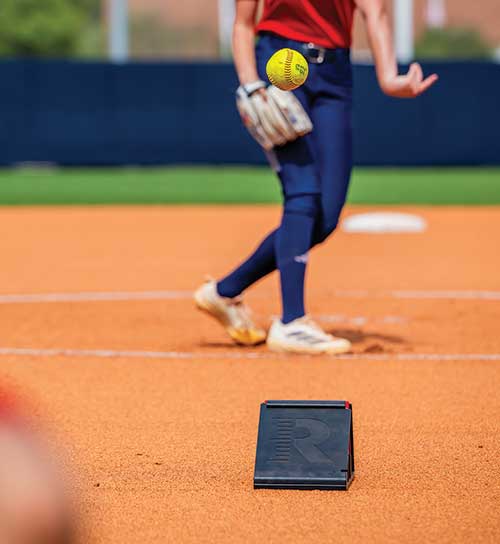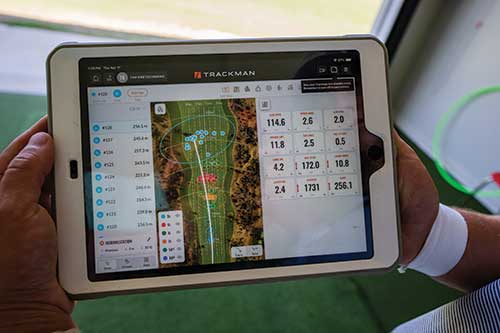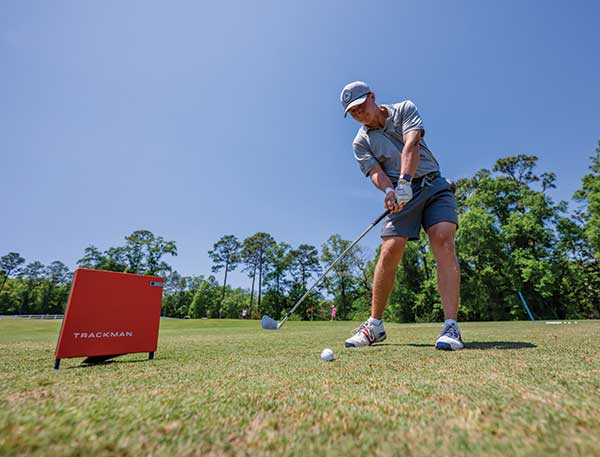Data Driven
Posted on June 5, 2025 by Steve Millburg
 AS SOON AS THE BALL IS RELEASED, the Rapsodo monitor captures everything a player
and coaches need to know.
AS SOON AS THE BALL IS RELEASED, the Rapsodo monitor captures everything a player
and coaches need to know.
Hannah Campbell keeps glancing between her pitcher and her iPad.
Campbell, associate head coach and pitching coach for South’s softball team, is leading a workout in the home-team bullpen at an otherwise empty Jaguar Field.
“You’re overthrowing,” she tells the player. “Trying to do too much. Let your fingers do the work.”
The pitcher nods. She winds up, then leaps forward, whipping the ball underhand toward the catcher. The ball zips over a small black plastic wedge that’s on the ground, then dives sharply as it crosses the plate.
Campbell looks at the iPad, then smiles.
“That’s the spin you want!” she says.
Campbell was an All-American pitcher for the Jaguars a decade ago. She’s a member of the South Alabama Athletic Hall of Fame. She knows pitching.
That black box — a pitch monitoring device, connected wirelessly to Campbell’s iPad — helps her know a lot more. It’s part of a flood of new technological marvels that use cameras, radar systems, lasers and other tools to help coaches design better athletes.
Monitors clock the speed of a pitch as well as the spin rate and axis, which are crucial to making it curve and dip. Other devices measure bat speed in baseball and softball, serve speed in tennis, sprint speed, vertical leap, heart rate, and just about every possible variable involving the interaction between a golf club and ball.
Technology has even invaded the weight room. A device that clips to a barbell measures how explosively and effectively an athlete lifts weights.
This technological boom has not supplanted the human factor. To pinpoint precisely what’s going on, check the tech. To figure out what to do with that information, ask the coach.
Or, as softball Head Coach Becky Clark puts it, “You can’t make up for bad coaching with good technology.”
 IN BETWEEN PITCHES, KOOPER BARNES checks her stats measured by the Rapsodo.
IN BETWEEN PITCHES, KOOPER BARNES checks her stats measured by the Rapsodo.
For example, a golfer might consistently hit the ball with the clubface at an angle instead of head-on, so the ball goes right or left instead of straight.
Electronic analyzers can detect that problem and precisely measure the clubface angle with each swing as the golfer works on a fix. South’s men’s and women’s golf clubhouse — seven miles from campus at Magnolia Grove, part of the renowned Robert Trent Jones Golf Trail — features two portable analyzers, one for swings and one for putting strokes.
An electronic analyzer can identify swing problems. It can’t tell you how to fix them. For that, says men’s golf Head Coach Ben Hannan, the player and coach head to the driving range.
“Sometimes in this game, we’re just standing there hitting a bucket of balls and trying things,” he says. He’ll suggest a tweak. The golfer tries it. Hannan checks the readouts. The two make adjustments until they find what works.
“What the technology has really helped with is getting to a potential answer much, much quicker,” Hannan says, “because you know at impact what’s happening in the relationship of the clubface and the golf ball.”
David Ventress, director of athletic performance for the men’s basketball and tennis teams, says coaches love his data-driven input. He’s technically support staff, but “they treat me like an assistant coach.”
 GOLF’S TRACKMAN MONITOR, similar to softball’s Rapsodo, gives Coach Ben Hannan and
golfer Hugo Thyr, right, real-time data on Thyr’s swing.
GOLF’S TRACKMAN MONITOR, similar to softball’s Rapsodo, gives Coach Ben Hannan and
golfer Hugo Thyr, right, real-time data on Thyr’s swing.
Ventress monitors weight room workouts. He uses laser devices to measure sprint speed, and sensor-equipped jump mats to track jumping ability. For every game, practice or conditioning session, athletes wear small fobs that record running speed and distance, jumps, starts and stops, and heart rate.
“We’ll download all the data,” he says. “I’ll put it into a graph and let the coaches look at the report.”
He might recommend that coaches push a certain player to work harder in practice, or suggest that another player might be fatigued and could use a lighter workload to prevent injury or regain strength for an upcoming tournament.
The numbers also present an opportunity to start conversations with players. “‘How’s your nutrition? How’s your sleep?’” Ventress says. “It allows you to actually see what’s causing the stress and what’s causing the guys not to be at their best.”
Having data for practices and workouts as well as official games and matches also allows coaches to leverage athletes’ competitive instincts. Here’s your sprint speed; think you can put in some extra workouts and beat it next week?
This March, softball player Gabby Stagner, who plays first base, became South’s career leader in runs batted in. The record came with two outs, on a ground ball to the shortstop’s backhand that Stagner hustled to beat out for a two-RBI single. The close play at first triggered a video review, which confirmed the call of safe.
 “What the technology has really helped with is getting to a potential answer much,
much quicker.” — MEN’S GOLF HEAD COACH BEN HANNAN
“What the technology has really helped with is getting to a potential answer much,
much quicker.” — MEN’S GOLF HEAD COACH BEN HANNAN
Stagner, a slugger who leads the team in home runs, had been working on getting faster. Clark says the coaches and players teased her that she owed the record to her blinding speed.
“Her times in the 20-yard sprint have been getting really good,” Clark says. “So it’s kind of a win for the strength coach too.”
Technology helped Stagner measure and improve a key component of her performance. But she still had to put in the work to make the improvement happen.
“The coaches have to know what they’re doing,” Clark says. “The player has to be able to execute.” Because, in the end, the bit of data that matters most is the number of wins.
Click here to view the current issue of South Magazine


